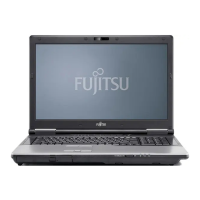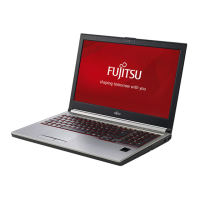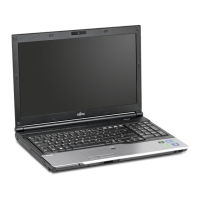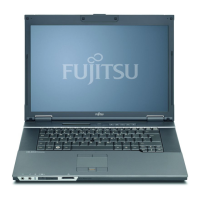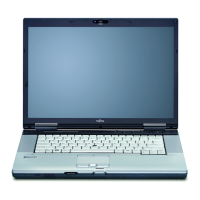How to resolve 'Failure Fixed Disk n' error on Fujitsu CELSIUS H970?
- RRichard WhiteSep 8, 2025
If your Fujitsu Laptop displays the error message 'Failure Fixed Disk n', start the BIOS Setup (Primary Master submenu) and select the correct settings.

How to resolve 'Failure Fixed Disk n' error on Fujitsu CELSIUS H970?
If your Fujitsu Laptop displays the error message 'Failure Fixed Disk n', start the BIOS Setup (Primary Master submenu) and select the correct settings.
How to correct the date and time on Fujitsu CELSIUS H970?
If the date or time is incorrect on your Fujitsu Laptop, you can set it in the main menu using the BIOS-Setup-Utility. If the issue persists, please contact your sales outlet or our Hotline/Service Desk.
Why Fujitsu CELSIUS H970 beeps every few seconds?
If a beep sounds every few seconds on your Fujitsu Laptop, the battery is almost flat. Charge the battery.
What to do if SmartCard reader is not recognised on Fujitsu CELSIUS H970?
If the SmartCard reader is not recognised on your Fujitsu Laptop, make sure you have inserted your SmartCard into the SmartCard reader with the chip facing upwards/downwards (device-dependent). Check whether the SmartCard you are using is supported and complies with the ISO standard 7816-1, -2, -3 and -4.
What does 'CMOS battery bad' mean on Fujitsu CELSIUS H970 Laptop?
If your Fujitsu Laptop displays the error message 'CMOS battery bad', and it occurs repeatedly, the buffer battery in the notebook is flat. Contact your sales outlet or our customer service centre.
| Form factor | Clamshell |
|---|---|
| Product type | Mobile workstation |
| Product color | Black |
| Panel type | TFT |
| LED backlight | Yes |
| Display surface | Matt |
| Display diagonal | 17.3 \ |
| Display brightness | 300 cd/m² |
| Native aspect ratio | 16:9 |
| Pointing device | Touchpad |
| Operating system architecture | 64-bit |
| Bus type | DMI3 |
| Stepping | R0 |
| Tjunction | 100 °C |
| Processor cache | 8 MB |
| Processor cores | 4 |
| Processor model | i7-6820HQ |
| System bus rate | 8 GT/s |
| Processor family | Intel® Core™ i7 |
| Processor series | Intel Core i7-6800 Mobile Series |
| Processor socket | BGA 1440 |
| Processor threads | 8 |
| Processor codename | Skylake |
| Processor frequency | 2.7 GHz |
| Processor cache type | Smart Cache |
| Configurable TDP-down | 35 W |
| Processor lithography | 14 nm |
| Processor manufacturer | Intel |
| Processor front side bus | - MHz |
| PCI Express slots version | 3.0 |
| Processor boost frequency | 3.6 GHz |
| PCI Express configurations | 1x16, 2x8, 1x8+2x4 |
| Thermal Design Power (TDP) | 45 W |
| Maximum number of PCI Express lanes | 16 |
| Memory slots | 4x SO-DIMM |
| Internal memory | 16 GB |
| Memory clock speed | 2133 MHz |
| Memory form factor | SO-DIMM |
| Internal memory type | DDR4-SDRAM |
| Maximum internal memory | 64 GB |
| SSD capacity | The Solid State Drive's storage capacity in Gigabytes. |
| SSD interface | PCI Express |
| Storage media | SSD |
| SSD form factor | M.2 |
| Optical drive type | DVD±RW |
| Total storage capacity | 256 GB |
| Compatible memory cards | MicroSD (TransFlash), MicroSDHC, SD, SDHC, SDXC |
| Number of SSDs installed | 1 |
| On-board graphics card ID | 0x191B |
| Discrete graphics card model | NVIDIA® Quadro® P3000 |
| On-board graphics card model | Intel® HD Graphics 530 |
| Discrete graphics card memory | 6 GB |
| Discrete graphics memory type | GDDR5 |
| On-board graphics card family | Intel® HD Graphics |
| Maximum on-board graphics card memory | 1.7 GB |
| On-board graphics card OpenGL version | 4.4 |
| On-board graphics card base frequency | 350 MHz |
| On-board graphics card DirectX version | 12.0 |
| On-board graphics card dynamic frequency (max) | 1050 MHz |
| Audio chip | Realtek ALC255 |
| Number of built-in speakers | 2 |
| Front camera resolution (numeric) | 2 MP |
| Battery life (max) | 9 h |
| AC adapter frequency | 50 - 60 Hz |
| AC adapter input voltage | 100 - 240 V |
| AC adapter output current | 13 A |
| AC adapter output voltage | 19.5 V |
| Cable lock slot type | Kensington |
| Password protection type | HDD, Supervisor, User |
| Wi-Fi standards | 802.11a, Wi-Fi 5 (802.11ac), 802.11b, 802.11g, Wi-Fi 4 (802.11n) |
| Top Wi-Fi standard | Wi-Fi 5 (802.11ac) |
| Ethernet LAN data rates | 10, 100, 1000 Mbit/s |
| Charging port type | DC-in jack |
| USB 2.0 ports quantity | 0 |
| USB 3.2 Gen 1 (3.1 Gen 1) Type-A ports quantity | 3 |
| Operating temperature (T-T) | 5 - 35 °C |
| Operating relative humidity (H-H) | 20 - 80 % |
| Sustainability certificates | RoHS, ENERGY STAR |
| Certification | CE |
| Processor code | SR2FU |
| Processor ARK ID | 88970 |
| Processor package size | 42 x 28 mm |
| Supported instruction sets | SSE4.1, SSE4.2, AVX 2.0 |
| Intel Smart Response Technology version | 1.00 |
| Depth | 288 mm |
|---|---|
| Width | 418 mm |
| Height | 30 mm |
| Weight | - g |
Identifies and describes the ports and indicators on the front of the notebook.
Identifies and describes the ports located on the left side of the notebook.
Identifies and describes the ports located on the right side of the notebook.
Identifies and describes components located on the bottom of the notebook.
Essential safety information that must be followed when working with the notebook.
Specific safety instructions for using wireless components like WLAN and Bluetooth.
Steps for unpacking and inspecting the device for any transportation damage.
Guidelines for choosing a safe and appropriate location for device setup.
Instructions on how to connect the notebook to the power supply.
Steps for powering on the device for the very first time.
Step-by-step guide on how to power on the notebook.
Procedures for safely shutting down the notebook to prevent data loss.
Details on keyboard layout, keys, and special functions.
Explains useful keyboard shortcuts and function key combinations.
Guide to using the touchpad and its buttons for navigation and selection.
How to properly charge, care for, and maintain the notebook battery.
Step-by-step instructions for removing and installing the notebook battery.
Setting up passwords in the BIOS for enhanced system security.
Detailed steps for assigning and managing BIOS supervisor and user passwords.
Configuring the system to require a password before booting the OS.
Setting up password protection for the notebook's hard disk drive.
General precautions and safety guidelines for handling internal components.
Steps to take before starting the removal or replacement of internal parts.
Procedures for adding or removing RAM modules.
Step-by-step guide to removing RAM modules from their slots.
Instructions for inserting new RAM modules into the notebook.
Procedures for installing and removing hard drives and M.2 storage devices.
Detailed steps for safely removing the notebook's hard disk drive.
Instructions for installing a new hard disk drive into the notebook.
Steps for removing an M.2 module installed on the mainboard.
Instructions for installing an M.2 module onto the mainboard.
Steps for removing an M.2 module located beneath the hard disk.
Instructions for installing an M.2 module located under the hard disk.
Final steps after component removal or installation to prepare the device.
Procedures for accessing and launching the BIOS Setup Utility.
